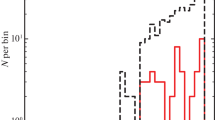Abstract
The initial discovery of soft X-rays from Nova Muscae 1983 was followed by eight additional observations of the three brightest novae whose outburst stage coincided with the lifetime ofEXOSAT satellite; namely three more observations of Nova Muscae 1983, three observations of Nova Vulpeculae 1984#1 (PW Vul), and two observations of Nova Vulpeculae 1984#2. Through these observations we sampled the soft X-ray light curve of classical novae from optical maximum to ∼900 days after. The observations seem best explained by the constant bolometric luminosity model of a hot white dwarf remnant. Although the measurements suffer from limited statistics, very broad energy bandpass, and incomplete sampling of any single nova, their constraints on the theories of nova outburst are significant. One constraint is that the lifetime of the white dwarf remnant in Nova Muscae 1983 is ∼2 to 3 years, which leads to the conclusion that the burned envelope massM burn should be of the order of\(10^{ - 6} \left( {\frac{{10^{38} erg s ^{ - 1} }}{{L_{burn} }}} \right)M_ \odot \). The second constraint is that the maximum temperature, of the white dwarf remnant should approximately be within 200 000 K to 400 000 K. We estimate that a white dwarf remnant evolving like the central star of a planetary nebula, with core mass of 0.8 to 0.9M ⊙, core luminosity of ∼2×104 L ⊙, and envelope mass of 10−6 M ⊙, can explain the general characteristics of the X-ray measurements for Nova Muscae 1983. In order to have ≥1.1M ⊙ core mass, estimated from the early observations of bolometric luminosity in the UV to infrared range, a wind withM≤5×10−7 M ⊙ yr−1 appears to be necessary. The few observations of Nova Vulpeculae 1984 #1 and Nova Vulpeculae 1984#2, during the first year after outburst, give a risetime and intensity that is consistent with a constant bolometric luminosity model.
Similar content being viewed by others
Author information
Authors and Affiliations
Rights and permissions
About this article
Cite this article
Ögelman, H., Krautter, J. & Beuermann, K. Exosat observations of X-rays from classical novae during outburst stage. Astrophys Space Sci 130, 279 (1987). https://doi.org/10.1007/BF00655007
Issue Date:
DOI: https://doi.org/10.1007/BF00655007




